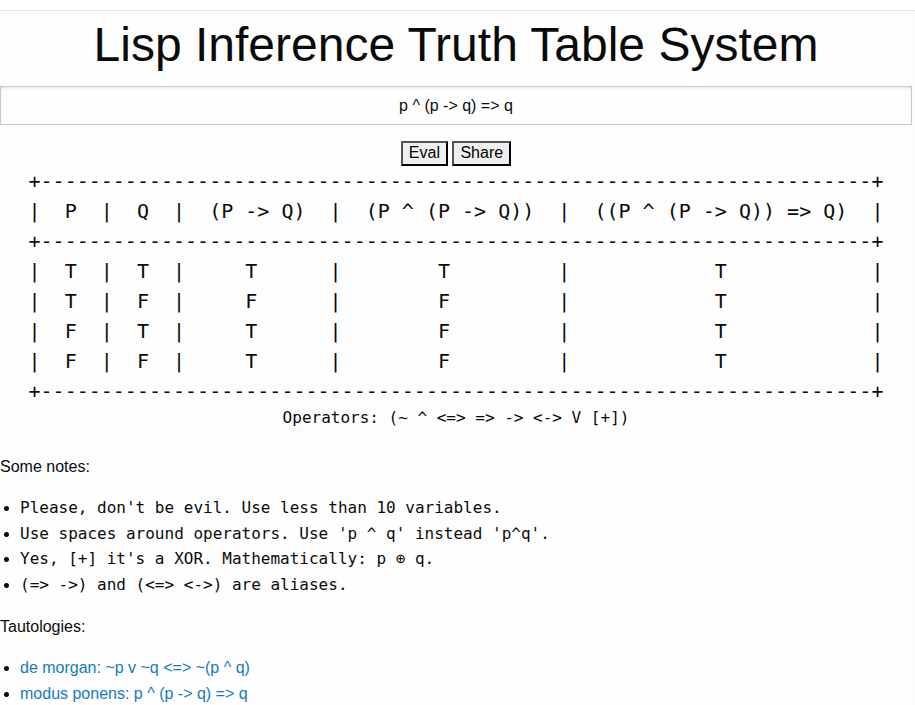Lisp Inference
I've been working on this since 2017. The current web application version is possible to access through logic.manoel.dev. The main page looks like this:

It's a application written in Common Lisp that is capable to generate a truth table for logical expressions. The source can be found in my github profile ryukinix/lisp-inference. It contains as well a share button so the users can share expressions with its truth table, some known tautologies are provided as hyperlinks as well.
Prologue
The initial system was designed to be a propositional calculus checker, in the sense of:
Given a set of K premises, show how we can deduce this conclusion C.
This was requested as an engineering task in my computer engineering graduation in 2014, during the first period. Funny, what did the professor think when requesting something like this for the students in the first year? The outcome was not good, as anyone could probably imagine. The project was designed to be split in such a way that part of the classroom was doing X, Y, Z… and in the end, the small parts would be glued together to form a "Propositional Calculator."
Well, this professor talked about Lisp to us, but what everyone had started to learn basically two months ago was programming in C. I'm not sure, but he really tried to convince us that a header called <lisp.h> was real and we could use it to process lists using C, using functions like car and cdr.
I'm not sure if the professor was going crazy or if it was just a lie, but this didn't exist. And most of the students were struggling to just implement linked lists. The result was a complete disaster; most of the groups, which were split from A to F, failed completely.
To this day, I think this impossible task was aimed at giving students a real feeling about how hard engineering is, because some weeks before this, the same professor was teaching us digital electronics, and after other hard courses (like calculus and physics), someone said, "Hey, this is easy." I think he took this personally, I'm not sure. Besides this, he was a great professor teaching digital electronics.
Anyway, since this failure, I had already read about Common Lisp because of Serial Experiments Lain a year ago (2013). Then, my interest in this increased even more because Lisp seemed like such an ALIEN technology, which was fascinating to me.
Common Lisp? Why?
Well, most part of the literature I've found abouth proof checkers, propositional logic and in the classic sense was written in Lisp. Curiously, most part of the books the professor shared was doctor thesis or really old books (from 197X).
To accomplish the initial task, that actually to see this happening, I decided to learn Common Lisp properly. Between 2015-2016 I was only looking superfially how Lisp works, how Emacs works… But not having much time to get into it. In 2017, however, I got a deep dive on it.
I started to read Structured and Interpretation of Computer Programmings (SICP), watched all the youtube course of MIT 6.001 of 1986 and read from start to end the book Land of Lisp (very fun to read, btw). All my notes about this journey of learning is scattered in some small code and notes in this repository called lisp-insights.
After thoroughly reading a lot about this and learning Common Lisp more profoundly, I decided to apply my recently acquired knowledge. The first project was actually Lisp Chat, a fun experience of managing a chat using raw TCP sockets and being capable of using even netcat as a client.
It's still 2017, three years since 2014, when my previous professor showed the nightmare of dealing with propositional calculus. In that year, I started lisp-inference and got some stuff working on generating truth tables, although this was not exactly the initial request.
To create a real logical proposition checker, I had to implement the Wang's Algorithm, which was, at that moment, beyond my comprehension of how I'd deal with it. I even tried to start, dealing with expression transformation, like simplification, double negation, equivalences, etc. An automation of human deduction of logical proofs.
Since then, I have worked on this project, improving it little by little each year. It's almost my personal laboratory for Common Lisp.
Refactor of Lisp Inference in 2025
I worked on revitilization of this application due being a important project for me, even without any practical usage. Some things was really important to deal with, including:
- implementing a pratt parser;
- implement a share button to share truth tables;
- change deprecated web framework weblocks to reblocks;
- restylize web application;
- changed testing framework prove to rove;
- add input validator:
- error handling of invalid expressions;
- reject expressions with more than 10 premisses;
- improve dockerfile build time from 8min to 1min
- ci/cd with new scheme of tests / deploy